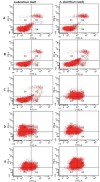Cytotoxic Activities of Certain Medicinal Plants on Different Cancer Cell Lines
- PMID: 32454617
- PMCID: PMC7227927
- DOI: 10.4274/tjps.80299
Cytotoxic Activities of Certain Medicinal Plants on Different Cancer Cell Lines
Abstract
Objectives: In recent years, the use of plants for the prevention and treatment of cancer is gaining more attention due to their diverse range of phytochemical constituents and fewer adverse effects. In this study, four medicinal plant species from the Kars province of Turkey were investigated for their cytotoxic potential against six different cancer cell lines and one normal cell line.
Materials and methods: MTT [3-(4,5-dimethylthiazol-2-yl)-2,5-dipenyltetrazolium bromide] assay was performed to assess cytotoxic activity and apoptotic effect was determined using flow cytometry and caspase-3 analyses.
Results: Significant cytotoxicity (≥70%) was observed with the leaf extract of Artemisia absinthium on A-549, CCC-221, K-562, MCF-7, PC-3 cells, whereas seed extracts caused significant cytotoxicity (≥70%) on CCC-221, K-562, MCF-7, PC-3 cells. Selective cytotoxicity was obtained with leaf extract on A-549 and K-562 cells; and with seed extract on K-562, MCF-7 and PC-3 cells compared with normal Beas-2B cells. The levels of cytotoxicity for both extracts were time- and dose-dependent at lower concentrations. Moreover, selective cytotoxicity (78%) was detected on A-549 cells with the seed extract of Plantago major. Cytotoxicity of extracts from Hyoscyamus niger and Amaranthus retrosa ranged between 10% and 30%.
Conclusion: A. absinthium extracts and P. major seed extract have potential for development as therapeutic agents for cytotoxicity on certain cancer cells following further investigation.
Keywords: Artemisia absinthium; Cytotoxicity; apoptosis; cancer cells; medicinal plants.
©Copyright 2017 Turk J Pharm Sci, Published by Galenos Publishing House.
Conflict of interest statement
Conflict of Interest: No conflict of interest was declared by the authors.
Figures




References
-
- Siegel R, Naishadham D, Jemal A. Cancer statistics, 2012. CA Cancer J Clin. 2012;62:10–29. - PubMed
-
- Huang T, Gong WH, Li XC, Zou CP, Jiang GJ, Li XH, Feng DP. Induction of apoptosis by a combination of paclitaxel and carboplatin in the presence of hyperthermia. Asian Pac J Cancer Prev. 2012;13:81–85. - PubMed
-
- Kintzios E. Terrestrial plant-derived anticancer agents and plant species used in anticancer research. Crit Rev Plant Sci. 2006;25:79–113.
-
- Pandi M, Kumaran RS, Choi YK, Kim HJ, Muthumary J. Isolation and detection of taxol, an anticancer drug produced from Lasiodiplodia theobromae, an endophytic fungus of the medicinal plant Morinda citrifolia. Afr J Biotechnol. 2011;10:1428–1435.
-
- Park HJ, Kim MJ, Ha E, Chung JH. Apoptotic effect of hesperidin through caspase3 activation in human colon cancer cells, SNU-C4. Phytomedicine. 2008;15:147–151. - PubMed
LinkOut - more resources
Full Text Sources
Research Materials
Miscellaneous
